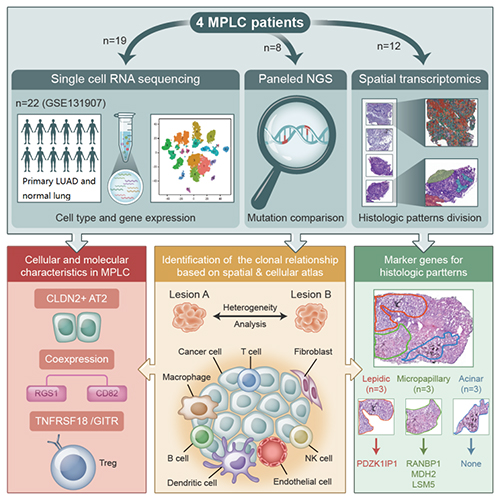A research group led by Prof. PIAO Hailong from the Dalian Institute of Chemical Physics (DICP) of the Chinese Academy of Sciences (CAS), in collaboration with Prof. LIU Hongxu's group from the department of Thoracic Surgery of the Liaoning Cancer Hospital & Institute, have characterized the cellular composition and spatial architecture of tumor microenvironment in human multiple primary lung cancers (MPLCs) by integrating single cell RNA-seq and spatial transcriptomics.
This study was published in Cell Death & Disease on July 25.

Illustration of cellular composition and spatial architecture of MPLCs based on single cell and spatial transcriptomics (Image by CHEN Di)
MPLCs refer to several primary tumors growing synchronously in the lung. With the widespread of high-resolution computed tomography, MPLCs are being diagnosed more frequently. However, it is still difficult to distinguish MPLC and intrapulmonary metastasis (IPM) in clinic, especially in cases of similar histologies.
In this study, the researchers conducted integrative analysis of both single-cell transcriptome and spatial transcriptome data based on bioinformatics and machine learning methods.
They identified a previously undescribed sub-population of epithelial cells termed as CLDN2+ alveolar type II (AT2), specifically enriched in MPLCs. Possessing a relatively stationary state, this subtype played an important role in cellular communication, aggregating spatially in tumor tissues and dominating the malignant histopathological patterns.
They verified that the CLDN2 protein expression could help distinguish MPLCs from intrapulmonary metastasis and solitary lung cancer. Moreover, they found that a cell surface receptor TNFRSF18/GITR was highly expressed in T cells of MPLCs, suggesting TNFRSF18 as one potential immunotherapeutic target in MPLCs. Meanwhile, high inter-lesion heterogeneity was observed in MPLCs.
"Our findings might provide insights into diagnostic biomarkers and therapeutic targets and advance our understanding of the cellular and spatial architecture of MPLCs," said Prof. PIAO.
This work was supported by the National Natural Science Foundation of China, the Dalian Science and Technology Innovation Funding, the Liaoning Revitalization Talents Program and etc.